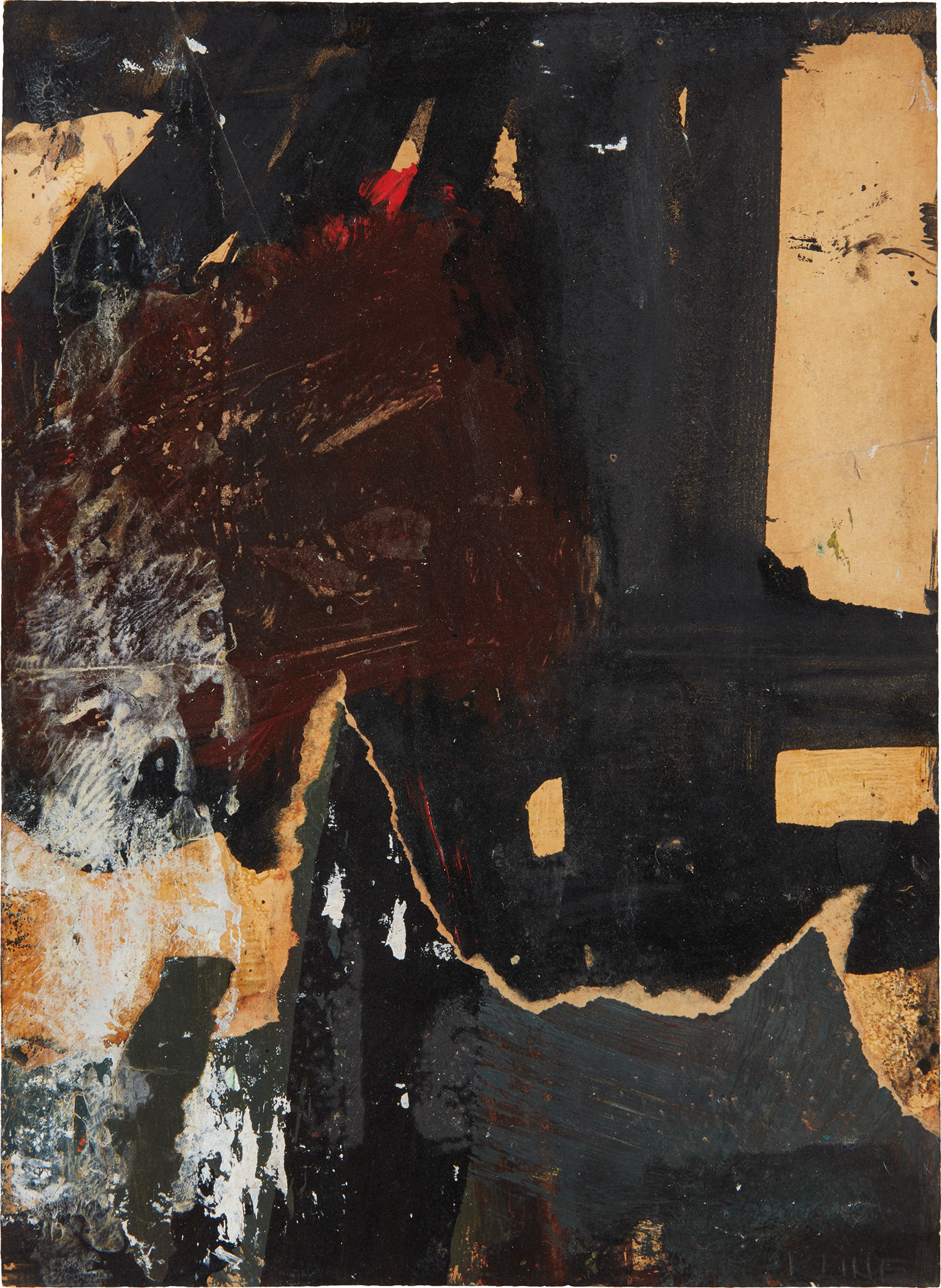

193
Franz Kline
Black, White, Brown
signed "KLINE" lower right; further signed "KLINE" on the reverse
oil, ink and paper collage mounted on board
11 3/8 x 8 1/4 in. (28.8 x 20.9 cm.)
Executed in 1959-1960.
Full-Cataloguing
“His sense of scale, that sine qua non of good painting, is marvelously precise. His big paintings can be as good as his small ones, a rare mastery in this period concerned with the power of magnitude...” – Robert Motherwell, 1962
Executed in 1959-1960, Black, White, Brown distills the extraordinary compositional balance of energy and restraint that has cemented Franz Kline as one of the foremost Abstract Expressionists. Created in the same year that Kline represented the United States at the 30th Venice Biennale in 1960, Black, White, Brown debuted at Galerie Änne Abels in Cologne on May 11, 1962, just two days prior to Kline’s untimely death. Among the last works in Kline’s oeuvre, Black, White, Brown powerfully speaks to the peak moment of creativity in Kline’s oeuvre – one in which he pushed his practice beyond his signature black slashes to explore the potential of color and the surface with the medium of collage.
Given that Kline’s seminal black-barred idiom originally emerged from the brush and ink drawings that depicted his urban surroundings in the 1940s, it is fitting that Black, White, Brown should be constructed of oil and ink on paper collage, a favored compositional structure for Kline’s small-scale works. In his studio, Kline would carefully adapt highly concentrated mixed-media collages and later project these works to large canvases. The present work powerfully puts into focus how Kline, like fellow Abstract Expressionists Willem de Kooning and Robert Motherwell, pioneered the medium of collage. Kline not only fused collage with the bold, fluid brushstrokes of his painterly practice, he in fact applied the notion of painterliness to collage itself – powerfully emulating the bold gesture of painting through the act of tearing paper on a more intimate scale.
Black, White, Brown epitomizes how Kline’s embrace of color as a compositional element starting around 1956 amplified the expressive force of his abstractions. In late works such as the present one, Kline approaches Rembrandt’s dramatic mastery of chiaroscuro, converting his black and white slashes into alternating tonalities of smoky painted space diffused with rich mahogany pigment and single flash of red – giving rise to a complex composition charged with the same sense of dynamism and drama as his iconic slash paintings. As the critic Thomas H. Hesse commented on Kline’s metamorphosis, “White and black forms still soar, tumble and stand in as permanent a state of instability as ever…But where before white and black edges met along a plane that had been painted and repainted, inched back and forth for months, now these passages are more spontaneous, and white canvas and charcoal appear as colors along contours and within shapes” (Thomas H. Hess, quoted in Franz Kline: 1910-1962, exh. cat, Castello di Rivoli, Turin, 2004, p. 319.)
Executed in 1959-1960, Black, White, Brown distills the extraordinary compositional balance of energy and restraint that has cemented Franz Kline as one of the foremost Abstract Expressionists. Created in the same year that Kline represented the United States at the 30th Venice Biennale in 1960, Black, White, Brown debuted at Galerie Änne Abels in Cologne on May 11, 1962, just two days prior to Kline’s untimely death. Among the last works in Kline’s oeuvre, Black, White, Brown powerfully speaks to the peak moment of creativity in Kline’s oeuvre – one in which he pushed his practice beyond his signature black slashes to explore the potential of color and the surface with the medium of collage.
Given that Kline’s seminal black-barred idiom originally emerged from the brush and ink drawings that depicted his urban surroundings in the 1940s, it is fitting that Black, White, Brown should be constructed of oil and ink on paper collage, a favored compositional structure for Kline’s small-scale works. In his studio, Kline would carefully adapt highly concentrated mixed-media collages and later project these works to large canvases. The present work powerfully puts into focus how Kline, like fellow Abstract Expressionists Willem de Kooning and Robert Motherwell, pioneered the medium of collage. Kline not only fused collage with the bold, fluid brushstrokes of his painterly practice, he in fact applied the notion of painterliness to collage itself – powerfully emulating the bold gesture of painting through the act of tearing paper on a more intimate scale.
Black, White, Brown epitomizes how Kline’s embrace of color as a compositional element starting around 1956 amplified the expressive force of his abstractions. In late works such as the present one, Kline approaches Rembrandt’s dramatic mastery of chiaroscuro, converting his black and white slashes into alternating tonalities of smoky painted space diffused with rich mahogany pigment and single flash of red – giving rise to a complex composition charged with the same sense of dynamism and drama as his iconic slash paintings. As the critic Thomas H. Hesse commented on Kline’s metamorphosis, “White and black forms still soar, tumble and stand in as permanent a state of instability as ever…But where before white and black edges met along a plane that had been painted and repainted, inched back and forth for months, now these passages are more spontaneous, and white canvas and charcoal appear as colors along contours and within shapes” (Thomas H. Hess, quoted in Franz Kline: 1910-1962, exh. cat, Castello di Rivoli, Turin, 2004, p. 319.)